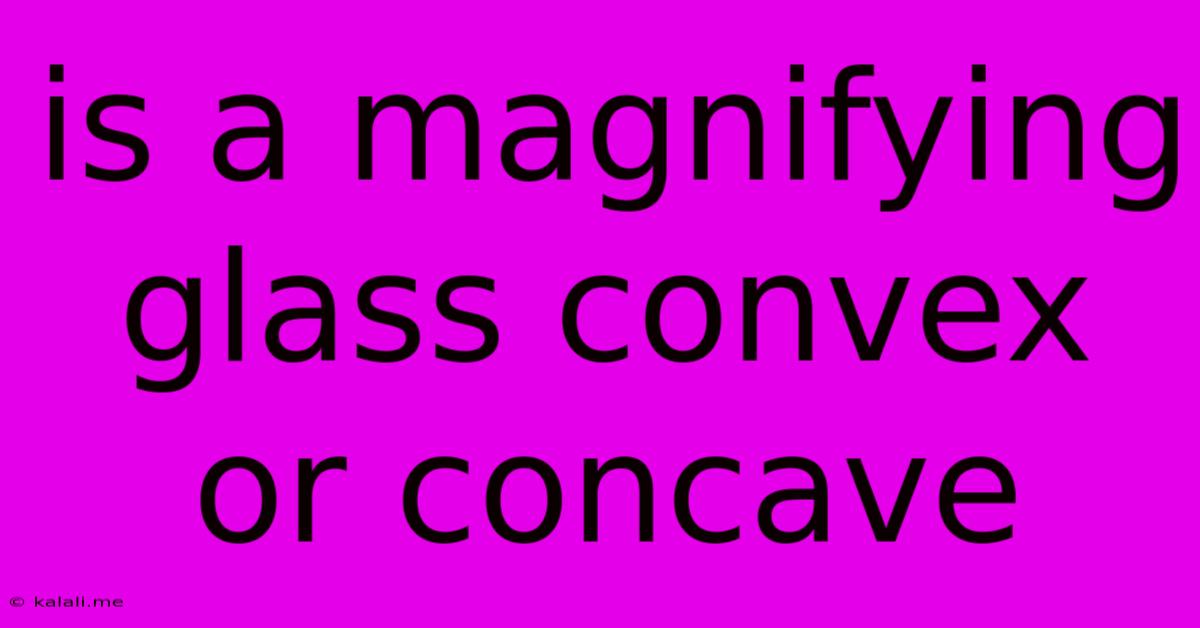Is A Magnifying Glass Convex Or Concave
Kalali
Jun 13, 2025 · 3 min read

Table of Contents
Is a Magnifying Glass Convex or Concave? Understanding Lenses and Magnification
A magnifying glass, that essential tool for examining tiny details, uses a specific type of lens to achieve its magnification. But is it a convex lens or a concave lens? The answer is simple: a magnifying glass uses a convex lens. Understanding why requires a brief look at the properties of each lens type.
This article will explore the characteristics of convex and concave lenses, explain why a magnifying glass utilizes a convex lens, and delve into how this lens type creates magnification. We’ll also touch upon the different applications of convex lenses beyond simple magnification.
Convex Lenses: The Heart of Magnification
A convex lens, also known as a converging lens, is thicker in the middle than at its edges. Its curved surface causes light rays to bend (refract) and converge at a single point called the focal point. This convergence is key to its magnifying properties. When an object is placed within the focal length of a convex lens, the lens forms a magnified, virtual image. This magnified image is what we see when we use a magnifying glass.
- Key Characteristics of Convex Lenses:
- Thicker in the middle than at the edges.
- Converges light rays.
- Forms real or virtual images, depending on object placement.
- Used in magnifying glasses, telescopes, microscopes, and eyeglasses for farsightedness (hyperopia).
Concave Lenses: Diverging the Light
In contrast, a concave lens, also known as a diverging lens, is thinner in the middle than at its edges. It causes parallel light rays to spread out or diverge after passing through the lens. This diverging effect means that a concave lens cannot form a magnified image. Instead, it forms a smaller, virtual, and upright image.
- Key Characteristics of Concave Lenses:
- Thinner in the middle than at the edges.
- Diverges light rays.
- Forms virtual, smaller, and upright images.
- Used in eyeglasses for nearsightedness (myopia).
Why a Magnifying Glass Needs a Convex Lens
The reason a magnifying glass uses a convex lens is directly related to its function: magnification. Only a convex lens can converge light rays to create a magnified image. The converging action of the convex lens brings the light rays from the object closer together, effectively enlarging the image projected onto the retina of your eye. A concave lens, with its diverging effect, would actually make the object appear smaller.
Beyond Magnification: Other Uses of Convex Lenses
Convex lenses are incredibly versatile and have numerous applications beyond magnifying glasses. They are crucial components in many optical instruments, including:
- Telescopes: Used to gather and focus light from distant objects.
- Microscopes: Essential for magnifying tiny objects, allowing for detailed examination.
- Cameras: Used to focus light onto the camera sensor or film.
- Projectors: Used to project images onto a screen.
- Eyeglasses for farsightedness: Correct vision by converging light rays onto the retina.
In conclusion, the answer to "Is a magnifying glass convex or concave?" is definitively convex. The converging nature of a convex lens allows it to magnify images, making it the ideal choice for this everyday tool and countless other optical applications. Understanding the differences between convex and concave lenses is fundamental to appreciating the science behind optics and the technology we use daily.
Latest Posts
Latest Posts
-
Which Of The Following Is Correctly Paired
Jun 14, 2025
-
Which Of The Following Is True Of Services
Jun 14, 2025
-
Uses Of Magnets In Daily Life
Jun 14, 2025
-
What Is The Resistance Of A Human Body
Jun 14, 2025
-
What Are The Factors Of 216
Jun 14, 2025
Related Post
Thank you for visiting our website which covers about Is A Magnifying Glass Convex Or Concave . We hope the information provided has been useful to you. Feel free to contact us if you have any questions or need further assistance. See you next time and don't miss to bookmark.